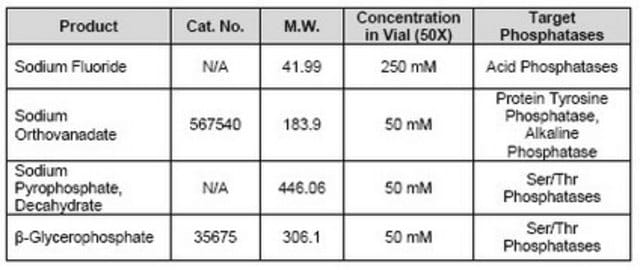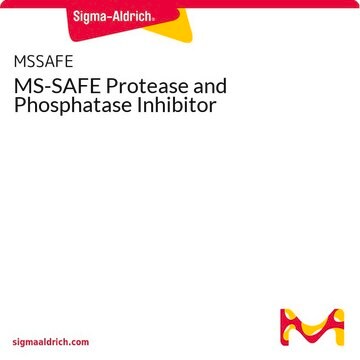524628
Phosphatase Inhibitor Cocktail IV
liquid, for the inhibition of serine/threonine and alkaline phosphatases
Sinonimo/i:
Phosphatase Inhibitor
About This Item
Prodotti consigliati
product name
Phosphatase Inhibitor Cocktail Set IV, Phosphatase inhibitor Cocktail Set IV is a cocktail of three phosphatase inhibitors for the inhibition of both serine/threonine and alkaline phosphatases.
Forma fisica
liquid
Produttore/marchio commerciale
Calbiochem®
Condizioni di stoccaggio
OK to freeze
protect from light
Condizioni di spedizione
wet ice
Temperatura di conservazione
−20°C
Categorie correlate
Descrizione generale
Azioni biochim/fisiol
Serine/threonine and alkaline phosphatases
Attenzione
Stato fisico
Ricostituzione
Note legali
Codice della classe di stoccaggio
10 - Combustible liquids
Classe di pericolosità dell'acqua (WGK)
WGK 1
Punto d’infiammabilità (°F)
188.6 °F - (refers to pure substance)
Punto d’infiammabilità (°C)
87 °C - (refers to pure substance)
Certificati d'analisi (COA)
Cerca il Certificati d'analisi (COA) digitando il numero di lotto/batch corrispondente. I numeri di lotto o di batch sono stampati sull'etichetta dei prodotti dopo la parola ‘Lotto’ o ‘Batch’.
Possiedi già questo prodotto?
I documenti relativi ai prodotti acquistati recentemente sono disponibili nell’Archivio dei documenti.
I clienti hanno visto anche
Il team dei nostri ricercatori vanta grande esperienza in tutte le aree della ricerca quali Life Science, scienza dei materiali, sintesi chimica, cromatografia, discipline analitiche, ecc..
Contatta l'Assistenza Tecnica.












